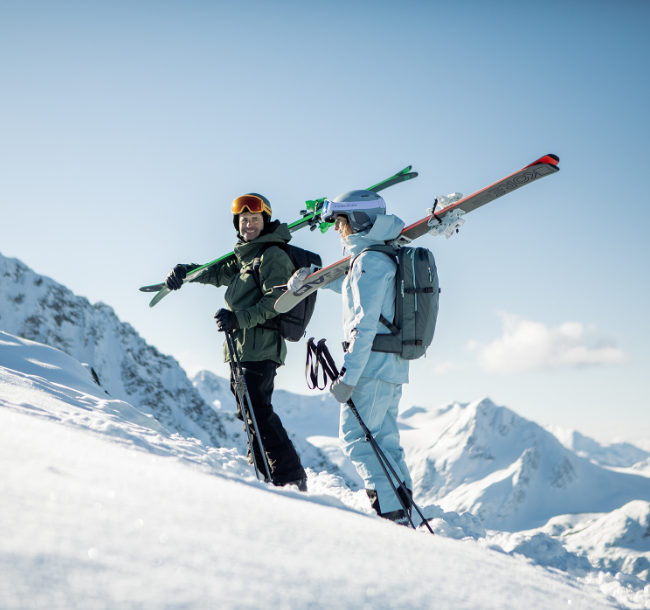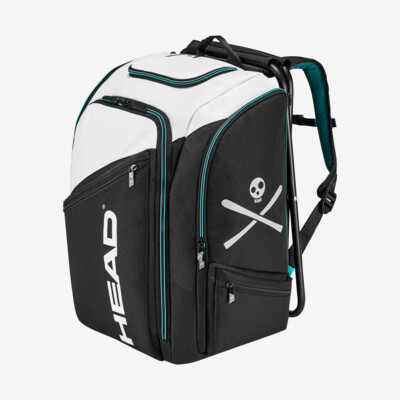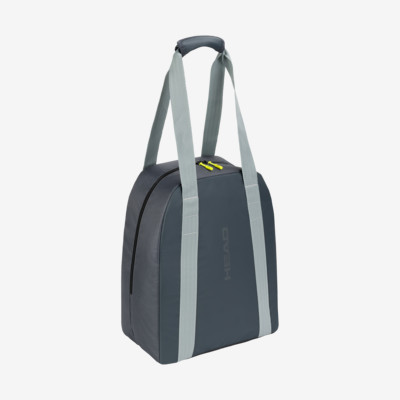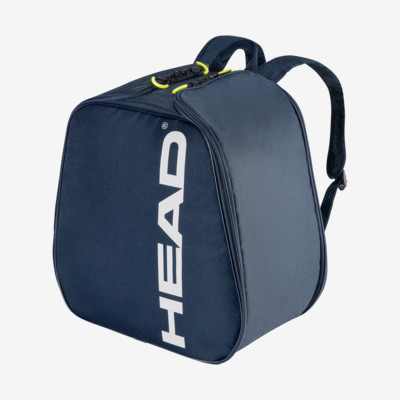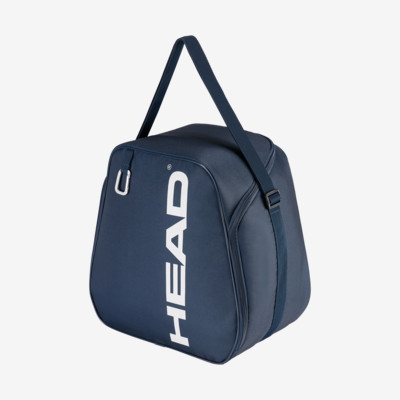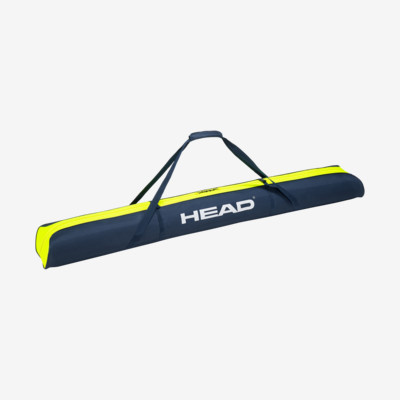When winter approaches, a familiar excitement sets in. Planning a trip to the mountains is a thrill and a challenge. Where should you go? What will the snow be like? And how will you people simply look for the cheapest flight or package deal, worrying about the details later.
But if you want to take your own equipment, there are a few key aspects to consider. Different types of luggage are available and different rules and restrictions apply to transporting it. Organising it may seem daunting, but this article will explain everything you need to know so that you and your skis reach your destination smoothly.
CHOOSE YOUR BAG
There is an enormous selection of ski bags available on the market, so choosing the right one or two can be confusing. The first step is to think about what is the easiest option for you personally. Would that be one large bag with everything in it or separate ski and boot bags plus a suitcase? Consider your level of strength and mobility when browsing.
WHEELIE BAGS
Bags with wheels, also known as ‘roller’ bags are built with durable, padded shells which protect equipment from damage and offer extra space for clothes and accessories. Wheels are a crucial feature of a snowsports bag. Without them, bags must be carried over the shoulder or on a trolley and this method is not always comfortable or possible. Wheeled bags are much easier to transport and manoeuvre around airports and public transport.
Without them, bags must be carried over the shoulder or on a trolley and this method is not always comfortable or possible. Wheeled bags are much easier to transport and manoeuvre around airports and public transport.
SKI AND BOOT BAGS
These range from basic shells to padded models with pockets. Boot bags provide enhanced protection for your precious footwear and often have space for a helmet plus extra storage for gloves and other kit. Back straps make boot bags much easier to haul around and there are plenty of carry-on designs to choose from. An advantage of using separate ski and boot bags is that it’s very manoeuvrable, with the possibility to store separate items in tight spaces around a car for example. Some airlines require hard cases and a specific level of protection for snowsports equipment so make sure to check the carriage restrictions in advance.

An advantage of using separate ski and boot bags is that it’s very manoeuvrable, with the possibility to store separate items in tight spaces around a car for example. Some airlines require hard cases and a specific level of protection for snowsports equipment so make sure to check the carriage restrictions in advance.
BEST OF BOTH WORLDS
Another option is to take both a ski bagand a large roller bag. Skis and poles can be stored in the ski bag and clothes, helmet and boots in the roller. If space allows, a second pair of skis can be stored horizontally along the length of the bag which adds some structural support. Large bags can be heavy, so be mindful to weigh everything before you leave and opt for a trolley at the airport to navigate safely.
SKI BAG PACKING TIPS
There is an art to packing efficiently into one bag which maximises storage space and protection. Skis should lie flat with the bindings folded down. Boots are heavy, so they should be stored at the wheel end of the bag to avoid discomfort when carrying.
Friction between pieces of equipment should be avoided at all costs, so clothing should be wrapped around it as padding with extra protection for bindings and ski tips. Smaller soft items such as socks, buffs and underwear can be stuffed into boots and poles should also be wrapped in clothing for protection. Ski bags have pockets to separate items so that although everything is packed in together, it can be organised.
Save space by being realistic about what you need. You will wear ski clothes every day so only a few casual items are required off the slope. Warm, comfortable clothes and one pair of snow-proof boots are essential. Maximise the space by rolling clothes instead of folding which squeezes out extra air.
Just like normal packing, it’s wise to double-bag toiletries which sometimes expand at altitude. A shampoo-drenched ski boot is not a good discovery to make! Additionally, bindings can shake loose with the vibrations of travel, so it’s good to bring a Philips head screwdriver to tighten them up if necessary.
DELICATE ITEMS
Valuable and fragile ski equipment such as goggles and transceivers need extra protection. If you choose to pack everything in one bag, these items can be protected inside helmets or cases. Hard items like shovels can also be used to shield other items from damage. It is best to take electronics such as cameras and laptops in hand luggage and remember to take batteries out of transceivers.
AIRLINE POLICIES
Most airlines are accustomed to transporting ski bags and booking is a straightforward process. But before you make the reservation, it is worth taking time to do some research into the baggage policy options for the airlines heading to your destination. Each airline has an individual policy regarding ski equipment, and it is possible to save money and avoid stress by properly assessing the options.
Baggage information can be found on the website of each airline and on their mobile applications. The options vary but ski and snowboard bags are usually categorised under sports equipment or oversized luggage. Some airlines count a ski and boot bag as one item while others charge separately.
There can also be weight restrictions for different types of bags. Packing and protection requirements also vary between airlines and some ask for snowsports equipment tobe packed in a hard case to prevent damage. It’s always worth checking exactly what conditions are specified.
If your bag looks like it’s struggling to contain everything, check-in staff may ask you to remove items, a headache easily avoided by careful packing. Avoid any surprise fines by weighing your case on bathroom scales before you leave and be prepared to take items out if the weight is over. Save space by wearing your ski jacket on the flight and storing it under the seat in front of you.
ON THE PLANE
It is possible to save some space in bags by taking items on board the plane, but not all airlines allow this. Sometimes boots can be carried and stored in overhead compartments, as long as they are secured and don’t risk damaging other items. Helmetscan also be taken on board in most cases and should be protected inside helmet bags to avoid scratching or damage.
Other small items such as goggles can be taken in rucksacks but it’s best to keep them inside a protective case to avoid damage. Skis and snowboards are too big to take in the cabin and must always be stored in the hold. Never assume that anything can be taken on board-always check the individual airline policy beforehand.
IN THE AIRPORT
Ski and snowboard bags are bulky and can be tricky to transport. Regardless of whether the bag has wheels, it can be easier to use a trolley to navigate the airport. Even if you are strong enough to carry your ski bag, a trolley reduces the physical strain ahead of your trip. Load it up with your case and rucksack and your back will thank you for it. There’s no need to strain any muscles before your snowsports adventure has even started!
Large pieces of luggage are often the last to be delivered to the collection point or conveyer belt so don’t panic if yourski bag doesn’t appear right away. Most airports have an oversized luggage section which is separate from the main conveyor belts, so ski bags sometimes end up there. Airline staff should be able to confirm this for you and it is especially important to establish where it will be delivered if you are making a connection.
Bear in mind that oversized luggage takes longer to arrive in the collection hall so enough time must be left to collect it and take it to the connecting transport service. If this is another flight, the bag will need to be checked in again which will also take some time. Avoid rushing by ensuring you have plenty of time between connections. Hurrying through a busy airport with a huge bag is not the most relaxing way to start a ski trip!
Ofcourse, the easiest way to take the hassle out of travelling with ski equipment is not to take it at all. Most ski resorts have rental services where you can source everything you need and drop it all off after your trip. This is worth considering if theprospect of carrying skis is putting you off the whole trip.
SAVE SOME MONEY
By taking the time to properly research the options, it is possible to save money. For example, if you are a frequent flyer and have racked up some miles, extra baggage is sometimes a perk. Additionally, money can be saved by booking baggage at the same time as the flight instead of adding it on at the last minute.
And finally, a cheap flight doesn’t always mean a cheap transport option. Although low-cost fares are available, baggage costs can be double or triple the price of the seat. Check the full cost of your flight plus luggage to avoid any expensive surprises and remember luggage must be checked on both the outward and return legs of the journey.
RAIL TRAVEL
Don’t forget thatthe mountains are also accessible by rail. Travelling by train is not only better for the planet, it’s more scenic and often cheaper. European ski destinations are especially well connected, with many resorts accessible directly by train. The key to having a relaxed rail journey to the slopes is anticipating where the luggage will be stored and secured.
Most trains linked to mountain resorts will have a carriage specifically for large luggage such as ski bags and bikes. To ensure a smooth journey, find outwhere exactly this wagon will be so that you can position yourself in the right place on the platform. When inside, store the bag lying down if possible, and check whether you can secure it with hooks so that it doesn’t pose a danger to other passengers.Make sure all zips are closed and locked for security then sit back and enjoy the views.
TRAVEL BY CAR
If you are lucky enough to live a driveable distance from the mountains, a car is all you need to get there with your gear. Skis can be stored on a roofrack which creates more space inside the car. Alternatively, if you choose to carry them inside the car then take the time to think about the safest and most secure way of transporting the equipment.
Put skis inside a lightweight bag and lie them across the boot. If they are too big for that, lay them through the middle of the car with a seat folded down. Make sure this does not obstruct the driver or passengers.
All equipment should be secured so that it won’t roll or damage the interior of the car. For example, make sure ski tips and pole ends are covered to avoid damage and keep boots and helmets in bags. Bungee cords and seatbelts can be used to keep equipment in place during travel. Travelling with skis and snowboards is not as difficult as you think.
Airlines and trains are accustomed to helping passengers reach their snowy destinations complete with all their equipment. The anticipation of a ski trip should fill you with joy, not dread. So take the time to plan your journey, factoring in everything onthis list, and you will be set up for a successful ski trip.
See the full range of HEAD New Zealand Ski & Boot bags HERE >>>

